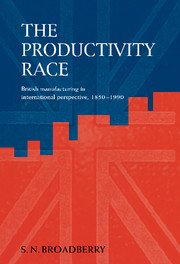Book contents
- Frontmatter
- Contents
- List of figures
- List of tables
- Acknowledgements
- Glossary of terms and company names
- 1 Introduction and overview
- Part 1 measuring comparative productivity performance
- Part 2 explaining compartive productivity performence
- Part 3 reassessing the performance of British industry
- Bibliography
- Index
1 - Introduction and overview
Published online by Cambridge University Press: 28 October 2009
- Frontmatter
- Contents
- List of figures
- List of tables
- Acknowledgements
- Glossary of terms and company names
- 1 Introduction and overview
- Part 1 measuring comparative productivity performance
- Part 2 explaining compartive productivity performence
- Part 3 reassessing the performance of British industry
- Bibliography
- Index
Summary
Introduction
Given the relative decline in British living standards over the period since the mid-nineteenth century, well known from Angus Maddison' (1982, 1991, 1995) work on national income statistics, it might be expected that British manufacturing productivity would exhibit a similar relative decline. In fact, however, as we can see from figure 1.1, this is not the case. Since the mid-nineteenth century British labour productivity in manufacturing has been about half the American level, and about the same as the German level. There have been some fairly sustained fluctuations around these levels, particularly around major wars, but in the long run these levels have been restored. Part 1 of this book is concerned with the establishment of these productivity patterns.
Part 2 then turns to the explanation of these productivity patterns in manufacturing. The key factor is the parallel development of different production techniques on the two sides of the Atlantic which, following Piore and Sabel (1984), Tolliday and Zeitlin (1991) and others, I have described as ‘mass production’ and ‘flexible production’, although, as I also stress, this is not inconsistent with producers having access to the same technology on both sides of the Atlantic. The key features of the two systems that I focus on concern (a) the degree of standardisation or customisation of output and (b) the skill of the shopfloor labour force. With mass production, standardised products are produced with special purpose machinery, requiring a relatively unskilled shopfloor labour force, while with flexible production, customised products are produced with general purpose machinery, requiring a highly skilled shopfloor labour force.
- Type
- Chapter
- Information
- The Productivity RaceBritish Manufacturing in International Perspective, 1850–1990, pp. 1 - 16Publisher: Cambridge University PressPrint publication year: 1997



